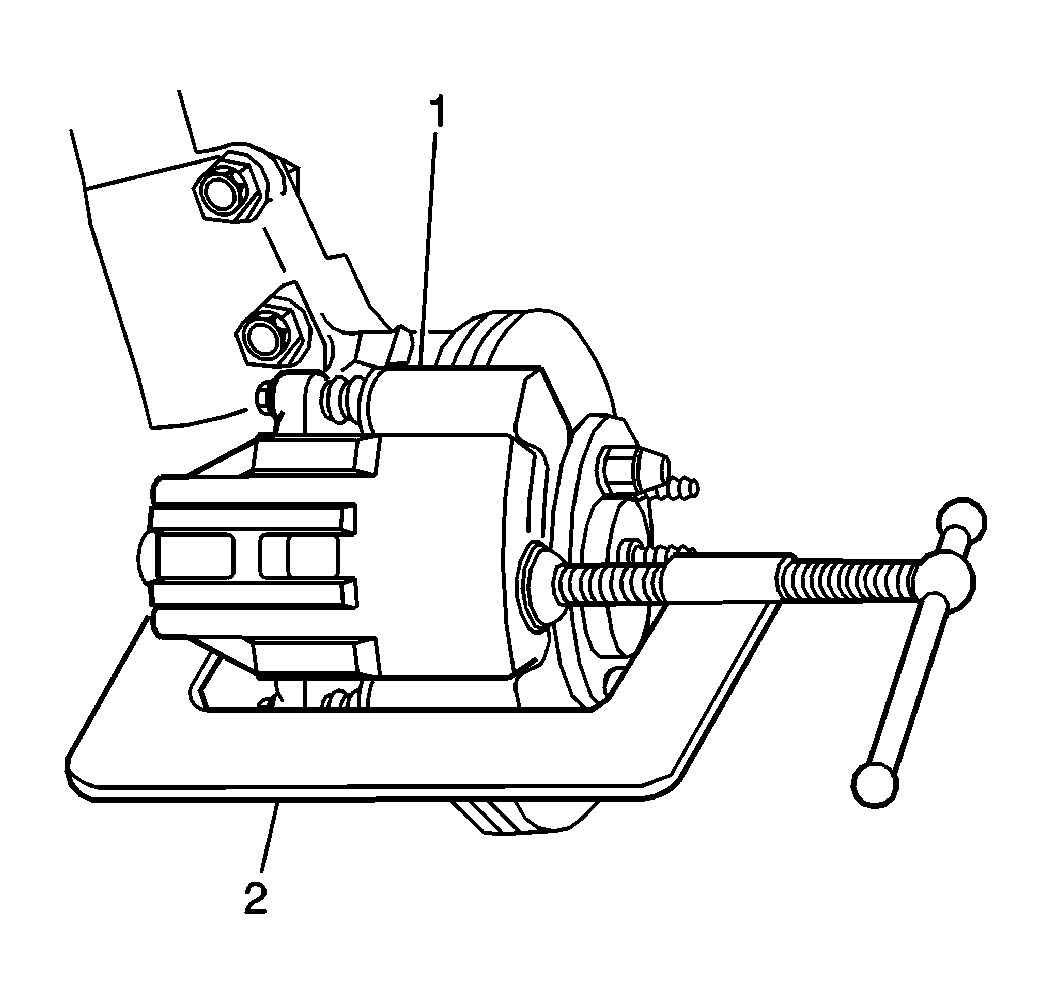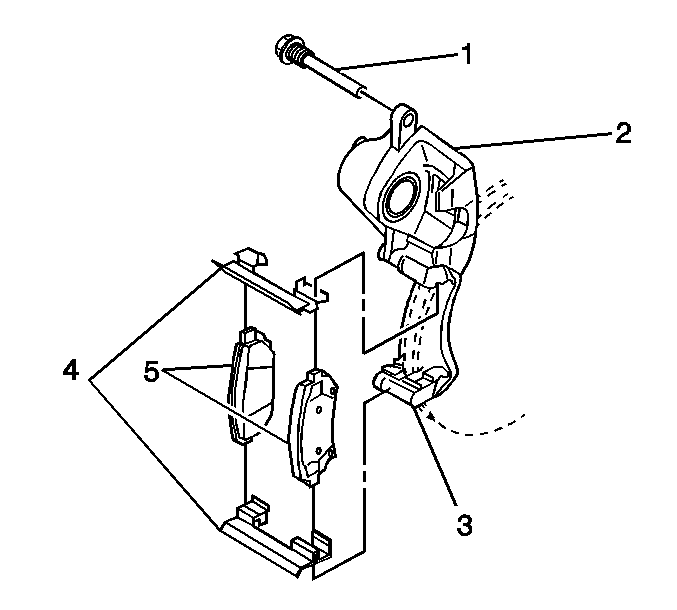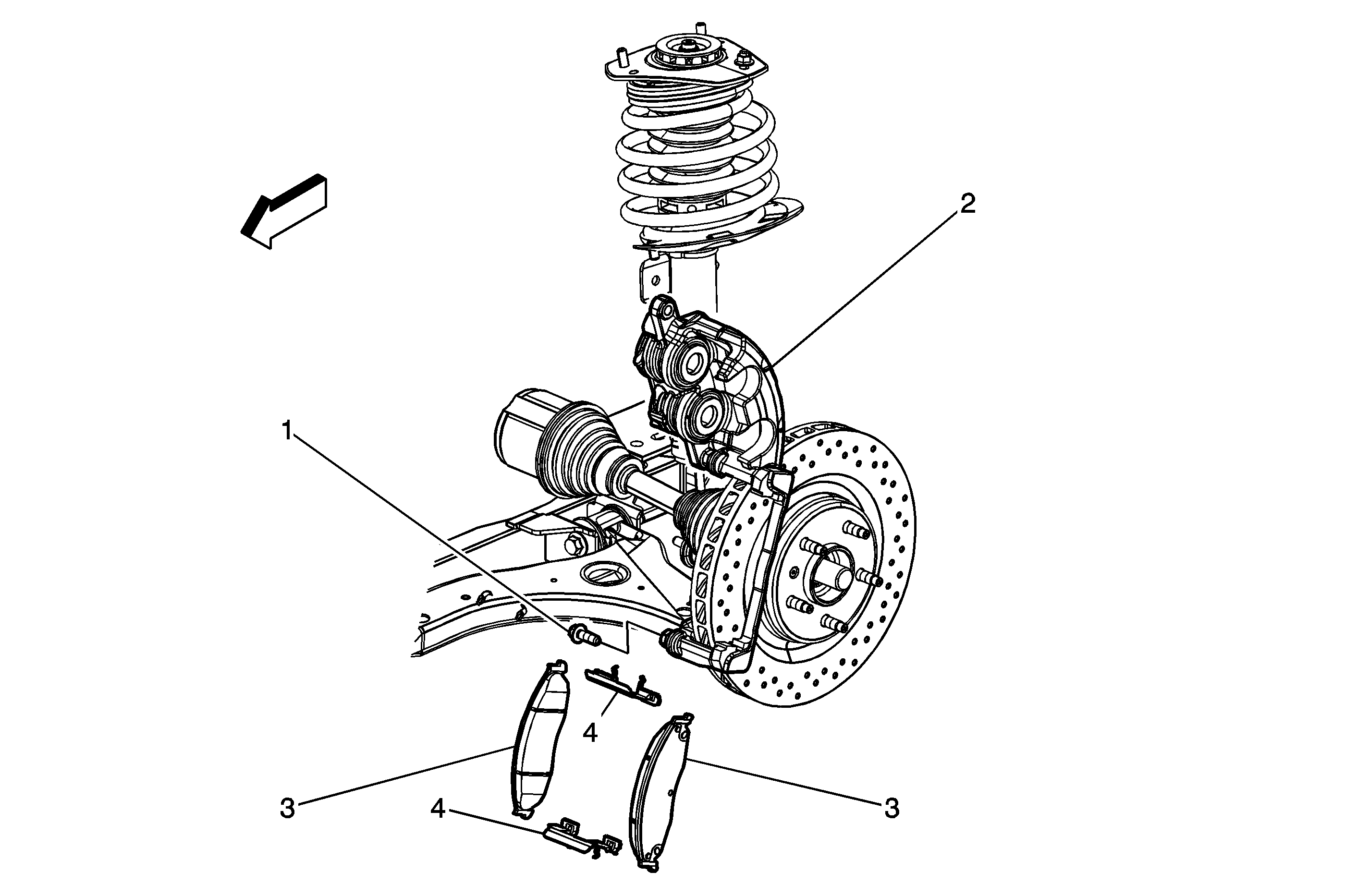Front Disc Brake Pads Replacement J65, JL9
Removal Procedure
Caution: Refer to Brake Dust Caution in the Preface section.
- Inspect the fluid level in the brake master cylinder reservoir.
- If the brake fluid level is midway between the maximum-full point and the minimum allowable level, then no brake fluid needs to be removed from the reservoir before proceeding. If the brake fluid level is higher than midway between the maximum-full point and the minimum allowable level, then remove brake fluid to the midway point before proceeding.
- Raise and suitably support the vehicle. Refer to Lifting and Jacking the Vehicle in General Information.
- Remove the tire and the wheel assembly. Refer to Tire and Wheel Removal and Installation in Tires and Wheels.
- Hand tighten 2 wheel lug nuts in order to retain the rotor to the hub.
- Compress the front caliper piston.
- Remove the lower caliper bolt (1).
- In order to access the pads, rotate the caliper upward and suitably support it.
- Remove the pads (5) from the caliper bracket (3).
- Remove the 2 retainer slides (4) from the caliper bracket (3).
- Inspect the following parts for cuts, tears, or deterioration. Replace any damaged parts:
- Inspect the caliper bolts (1) for corrosion or damage. If corrosion is found, use new caliper bolts when installing the caliper.

| 6.1. | Install a large C-clamp (2) over the top of the caliper housing (1) and against the back of the outboard pad. |
| 6.2. | Slowly tighten the C-clamp (2) until the piston pushes into the caliper bore enough to slide the caliper (1) off the rotor. |
| 6.3. | Remove the C-clamp from the caliper. |

Notice: Use care to avoid damaging pin boot when rotating caliper.
| • | The disc brake mounting and hardware -- Refer to Front Disc Brake Mounting and Hardware Inspection . |
| • | The caliper dust boot -- Refer to Brake Caliper Inspection . |
Installation Procedure
- Using a C-clamp, bottom the piston into the caliper bore. Use an old brake pad or wooden block across the face of the piston. Do not damage the piston or the caliper boot.
- Install the 2 retainers to the caliper bracket.
- Install the pads (5) to the caliper anchor bracket (3).
- Remove the support and reposition the caliper (2) back down over the front pads.
- Lubricate the pin bolt and the inner diameter of the bolt boot with GM P/N 18047666, or equivalent. Do not lubricate the threads of the pin bolt.
- Install the lower caliper bolt.
- Remove the 2 wheel lug nuts retaining the rotor to the hub.
- Install the tire and the wheel assembly. Refer to Tire and Wheel Removal and Installation in Tires and Wheels.
- Lower the vehicle.
- With the engine OFF, gradually apply the brake pedal to approximately 2/3 of its travel distance.
- Slowly release the brake pedal.
- Wait 15 seconds, then repeat steps 10 and 11 until a firm brake pedal is obtained. This will properly seat the brake caliper pistons and brake pads.
- Fill the brake master cylinder reservoir to the proper level. Refer to Master Cylinder Reservoir Filling in Hydraulic Brakes.
- Burnish the pads and rotors. Refer to Brake Pad and Rotor Burnishing .

Important: The wear sensor is on the outside pad. The sensor is positioned at the leading or upward edge of the pad during forward wheel rotation.
Notice: Use care to avoid damaging pin boot when rotating caliper.
Notice: Use the correct fastener in the correct location. Replacement fasteners must be the correct part number for that application. Fasteners requiring replacement or fasteners requiring the use of thread locking compound or sealant are identified in the service procedure. Do not use paints, lubricants, or corrosion inhibitors on fasteners or fastener joint surfaces unless specified. These coatings affect fastener torque and joint clamping force and may damage the fastener. Use the correct tightening sequence and specifications when installing fasteners in order to avoid damage to parts and systems.
Tighten
Tighten the caliper bolts to 95 N·m (70 lb ft).
Front Disc Brake Pads Replacement Z7U

Callout | Component Name | ||||||
|---|---|---|---|---|---|---|---|
|
Caution: Refer to Brake Dust Caution in the Preface section. Notice: Support the brake caliper with heavy mechanic wire, or equivalent, whenever it is separated from its mount and the hydraulic flexible brake hose is still connected. Failure to support the caliper in this manner will cause the flexible brake hose to bear the weight of the caliper, which may cause damage to the brake hose and in turn may cause a brake fluid leak. Preliminary Procedures
| |||||||
1 | Bolt, Brake Caliper Pin Notice: Refer to Fastener Notice in the Preface section. Tighten | ||||||
2 | Caliper, Brake Tip
| ||||||
3 | Pads, Disc Brake | ||||||
4 | Retainer, Brake Pad Spring (Qty: 2) Tip
| ||||||
